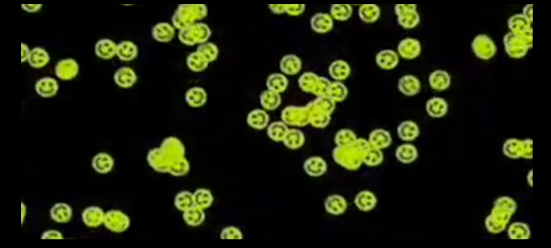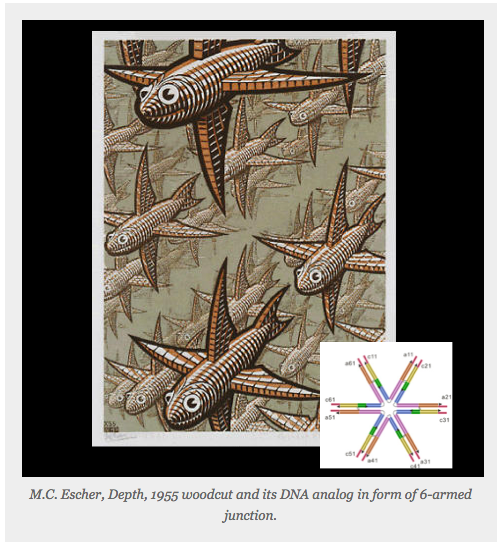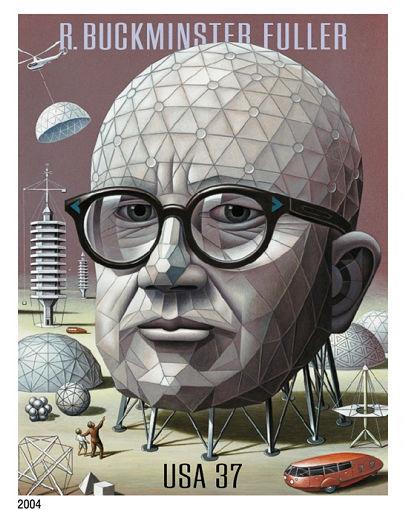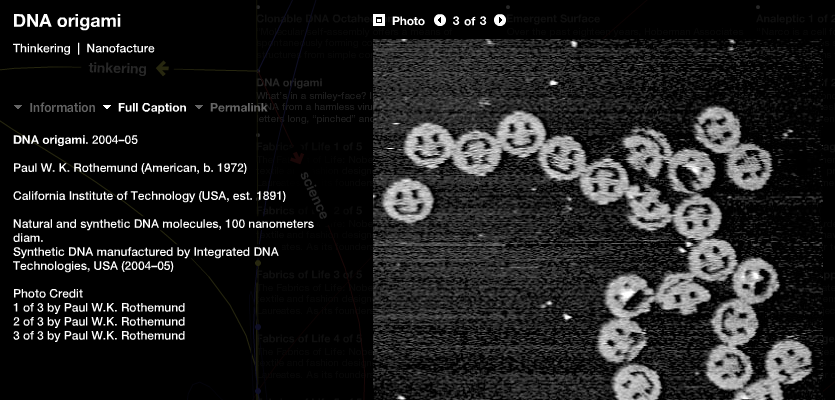Art and Design with DNA
DNA is just chemists' shorthand for deoxyribonucleic acid. Discovered in 1869 by Friedrich Miescher, a Swiss physician, it was the iconic molecule of the 20th century. And now an art and design material for the 21st... For much of the late 20th century, scientists, writers, and the general public imagined the beautiful, elegant double helix of DNA as information. It was code in the form of a chemical, a molecule that directed our development and determined our destiny. This discourse served to organize, guide, and inform the research agenda of scientists for decades.Starting in the late 1970s, a few scientists began to rethink what DNA was and what they might be able to do with it. Chemists, crystallographers, molecular biologists, and computer scientists self-assembled themselves into new interdisciplinary research community focused on what came to be called DNA nanotechnology.Instead of just seeing DNA as a blueprint, they began to think of it as a brick - something to build things with. Triangles, lattices, cubes...scientists used DNA to make two-dimensional and, in time, three-dimensional shapes. Consider these forms made by Caltech's Paul Rothemund using a technique he developed and refined called DNA origami. Rothemund's choice of origami wasn't coincidental; he had to argue with editors and reviewers at Nature for its use.
For much of the late 20th century, scientists, writers, and the general public imagined the beautiful, elegant double helix of DNA as information. It was code in the form of a chemical, a molecule that directed our development and determined our destiny. This discourse served to organize, guide, and inform the research agenda of scientists for decades.Starting in the late 1970s, a few scientists began to rethink what DNA was and what they might be able to do with it. Chemists, crystallographers, molecular biologists, and computer scientists self-assembled themselves into new interdisciplinary research community focused on what came to be called DNA nanotechnology.Instead of just seeing DNA as a blueprint, they began to think of it as a brick - something to build things with. Triangles, lattices, cubes...scientists used DNA to make two-dimensional and, in time, three-dimensional shapes. Consider these forms made by Caltech's Paul Rothemund using a technique he developed and refined called DNA origami. Rothemund's choice of origami wasn't coincidental; he had to argue with editors and reviewers at Nature for its use. From this tinkering and engineering emerged a growing zoo of DNA machines like "walkers" that could carry molecules and place them with precision. In true Fordist fashion, artificial DNA is now mass-produced - synthesized via machine with instructions sent over the Internet - as the scientist's hand-crafted strands of DNA gave way to economies of scale.
From this tinkering and engineering emerged a growing zoo of DNA machines like "walkers" that could carry molecules and place them with precision. In true Fordist fashion, artificial DNA is now mass-produced - synthesized via machine with instructions sent over the Internet - as the scientist's hand-crafted strands of DNA gave way to economies of scale. DNA nanotechnology is but one room in the expanding house of synthetic biology - the deliberate construction of biological systems to do useful things. This is, as the title of Rob Carlson's 2011 book suggests, thinking of biology as technology. And, like all other technologies, macroscale or nanoscale, synthetic biology depends on a foundation of design. And this means that DNA nanotechnology has an aesthetic component. Some forms and some structures are inherently more beautiful, more pleasing, than others.This shouldn't surprise us. From its beginnings, DNA nanotechnology was prompted by art. Most famously, NYU chemist and DNA nanotech pioneer Nadrian "Ned" Seeman found inspiration in a pint of beer and his recollection of M.C. Escher's 1955 painting Depth.
DNA nanotechnology is but one room in the expanding house of synthetic biology - the deliberate construction of biological systems to do useful things. This is, as the title of Rob Carlson's 2011 book suggests, thinking of biology as technology. And, like all other technologies, macroscale or nanoscale, synthetic biology depends on a foundation of design. And this means that DNA nanotechnology has an aesthetic component. Some forms and some structures are inherently more beautiful, more pleasing, than others.This shouldn't surprise us. From its beginnings, DNA nanotechnology was prompted by art. Most famously, NYU chemist and DNA nanotech pioneer Nadrian "Ned" Seeman found inspiration in a pint of beer and his recollection of M.C. Escher's 1955 painting Depth.  From this came Seeman's conviction, expressed in a 1982 article, that junctions of DNA could be deliberately arranged so as to form periodic shapes and structures. Looking beyond Escher's influence, Seeman believes that the inspiration for much of the best work in DNA nanotechnology has been art. As Seeman recently wrote in the art-science journal Leonardo, "Art can often supply useful analogs of the systems we ponder."Consider these shapes made from bundles of DNA helices by researchers at William Shih's Harvard lab:
From this came Seeman's conviction, expressed in a 1982 article, that junctions of DNA could be deliberately arranged so as to form periodic shapes and structures. Looking beyond Escher's influence, Seeman believes that the inspiration for much of the best work in DNA nanotechnology has been art. As Seeman recently wrote in the art-science journal Leonardo, "Art can often supply useful analogs of the systems we ponder."Consider these shapes made from bundles of DNA helices by researchers at William Shih's Harvard lab: They appear in a 2010 paper Shih and his collaborators published in Nature Nanotechnology. The title of their paper - "Self-assembly of three-dimensional prestressed tensegrity structures from DNA - contains the essential clue."Tensegrity" was a word coined by designer-guru-bullshit artist R. Buckminster Fuller in the 1950s. A portmanteau of tension + integrity, the term meant the reliance of compression and tension to create a stable structure. As Art News reported in 1959, "Of all the ways out of the blind alley in which so much of modern architecture luxuriously relaxes," Fuller's "tensegrity structures seem the most inventive and promising."
They appear in a 2010 paper Shih and his collaborators published in Nature Nanotechnology. The title of their paper - "Self-assembly of three-dimensional prestressed tensegrity structures from DNA - contains the essential clue."Tensegrity" was a word coined by designer-guru-bullshit artist R. Buckminster Fuller in the 1950s. A portmanteau of tension + integrity, the term meant the reliance of compression and tension to create a stable structure. As Art News reported in 1959, "Of all the ways out of the blind alley in which so much of modern architecture luxuriously relaxes," Fuller's "tensegrity structures seem the most inventive and promising." Fuller derived the idea for tensegrity via his collaboration with artist Kenneth Snelson in 1948-49 when they were both at Black Mountain College in North Carolina. Fuller adopted - some might say co-opted without sufficient attribution - Snelson's ideas, patented the concept, and incorporated it into his iconic design for that quintessential Cold War/hippy architectural form, the geodesic dome. Snelson, meanwhile, continued to use the technique for his own sculptures.
Fuller derived the idea for tensegrity via his collaboration with artist Kenneth Snelson in 1948-49 when they were both at Black Mountain College in North Carolina. Fuller adopted - some might say co-opted without sufficient attribution - Snelson's ideas, patented the concept, and incorporated it into his iconic design for that quintessential Cold War/hippy architectural form, the geodesic dome. Snelson, meanwhile, continued to use the technique for his own sculptures. In the Shih, et al. paper, "rigid bundles of DNA double helices resist compressive forces exerted by segments of single-stranded DNA that act as tension-bearing cables." The result is structures that show great stability as well as high strength-to-weight ratios. The paper's opening paragraph acknowledges a clear design debt to Snelson (and Fuller).There's a symmetry here that goes beyond structure as well. When carbon-60 molecules were fabricated in 1985, discoverers Richard Smalley, Harold Kroto, and Robert Curl dubbed it Buckminsterfullerene...Bucky balls, for short. The work by Shih, et al. links another nanostructure back to Fuller (and Snelson).While design is central to the work of synthetic biologists, professional designers have recently linked their interests with those of research scientists. For example, in 2014, an edited collection called Synthetic Aesthetics brought together essays that originated in an "experimental, international research project between synthetic biology, art, design and social science." The shared purpose of the Synthetic Aesthetics group was, now that biologists could design nature, to explore "how we might design it well."
In the Shih, et al. paper, "rigid bundles of DNA double helices resist compressive forces exerted by segments of single-stranded DNA that act as tension-bearing cables." The result is structures that show great stability as well as high strength-to-weight ratios. The paper's opening paragraph acknowledges a clear design debt to Snelson (and Fuller).There's a symmetry here that goes beyond structure as well. When carbon-60 molecules were fabricated in 1985, discoverers Richard Smalley, Harold Kroto, and Robert Curl dubbed it Buckminsterfullerene...Bucky balls, for short. The work by Shih, et al. links another nanostructure back to Fuller (and Snelson).While design is central to the work of synthetic biologists, professional designers have recently linked their interests with those of research scientists. For example, in 2014, an edited collection called Synthetic Aesthetics brought together essays that originated in an "experimental, international research project between synthetic biology, art, design and social science." The shared purpose of the Synthetic Aesthetics group was, now that biologists could design nature, to explore "how we might design it well." This confluence of interest and bridging of research cultures formed the basis for a symposium at the Museum of Modern Art called "Synthetic Aesthetics: New Frontiers in Contemporary Design."This wasn't MoMA's first foray into spaces where design and art meet 21st century technology and science. In 2008, the museum featured a multi-week exhibit called "Design and the Elastic Mind." Like the 2014 venture, it focused on "the reciprocal relationship between science and design in the contemporary world."
This confluence of interest and bridging of research cultures formed the basis for a symposium at the Museum of Modern Art called "Synthetic Aesthetics: New Frontiers in Contemporary Design."This wasn't MoMA's first foray into spaces where design and art meet 21st century technology and science. In 2008, the museum featured a multi-week exhibit called "Design and the Elastic Mind." Like the 2014 venture, it focused on "the reciprocal relationship between science and design in the contemporary world." A highlight in the 2008 exhibition was Paul Rothemund's lab-derived and tour-de-force of design, the now-iconic DNA-based smiley faces. The museum still has a web-version of the exhibit. This is the on-line entry for Rothemund's contribution:
A highlight in the 2008 exhibition was Paul Rothemund's lab-derived and tour-de-force of design, the now-iconic DNA-based smiley faces. The museum still has a web-version of the exhibit. This is the on-line entry for Rothemund's contribution: MoMA also included William Shih in its 2008 show. His "clonable DNA octahedron" - derived from a 2004 research article - represented a single strand of DNA that folded itself into an octahedral structure that was about 20 nanometers in size.
MoMA also included William Shih in its 2008 show. His "clonable DNA octahedron" - derived from a 2004 research article - represented a single strand of DNA that folded itself into an octahedral structure that was about 20 nanometers in size. The design-based research-turned-art that scientists contributed to the MoMA show closed a circle of sorts. For Ned Seeman, art had inspired the DNA structures he first theorized and then fabricated. ((This was by no means the first confluence of nanotech and art. A special issue of Leonardo in 2012 featured several pieces about the "images and art of nanotechnologies. And, of course, nanotech in general has been highly dependent on image and representation throughout its long history.)) Jump ahead a quarter century - the structures designed and made by Rothemund and Shih using the tools and techniques of DNA nanotechnology are the art.
The design-based research-turned-art that scientists contributed to the MoMA show closed a circle of sorts. For Ned Seeman, art had inspired the DNA structures he first theorized and then fabricated. ((This was by no means the first confluence of nanotech and art. A special issue of Leonardo in 2012 featured several pieces about the "images and art of nanotechnologies. And, of course, nanotech in general has been highly dependent on image and representation throughout its long history.)) Jump ahead a quarter century - the structures designed and made by Rothemund and Shih using the tools and techniques of DNA nanotechnology are the art.